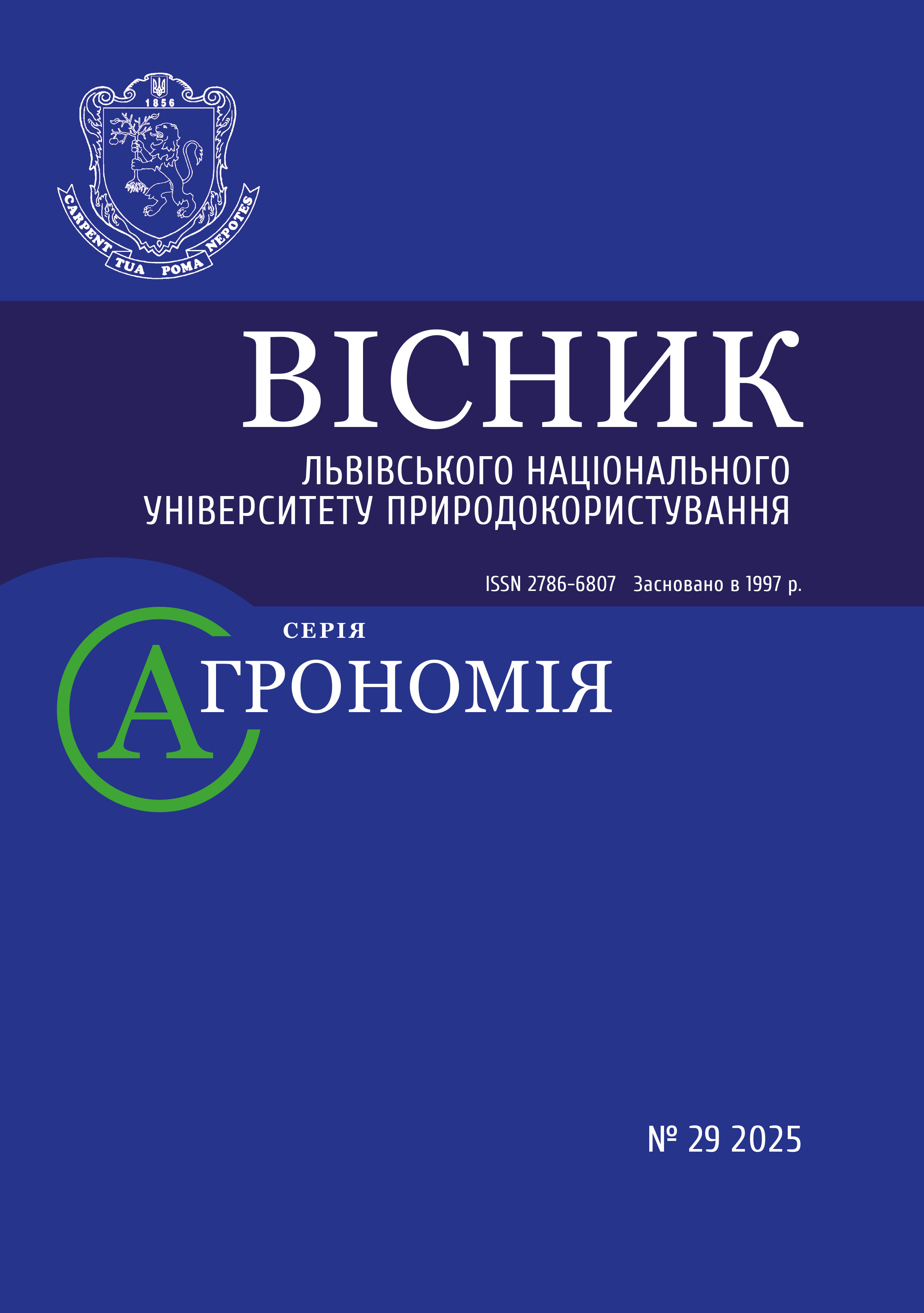YIELD OF CORN HYBRIDS DEPENDING ON THE DENSITY OF AGROPHYTOCENOSIS
DOI:
https://doi.org/10.31734/agronomy2025.29.086Keywords:
Western Forest-Steppe zone, corn, hybrids, sowing density, grain yieldAbstract
Corn is an important source of feed and food resources, and in recent decades it has also become an important energy crop. The current state of the energy industry has led to a significant increase in demand for corn grain on the world market. The latter has largely determined the fact that the area sown with corn in Ukraine has more than doubled and now amounts to about 5 million hectares.
An important reserve for increasing the gross production of corn grain is the introduction of adaptive technology for growing hybrids, which would take into account their genotypic characteristics, as well as a possible reaction to individual elements of the technology. In the complex of elements of corn growing technology, an important place is occupied by the formation of the optimal density of agrophytocenosis. The latter should ensure not only a favorable phytosanitary condition of the corn field, but also contribute to the maximum realization of the genetic potential of the crop.
The issue of optimal seeding density remains relevant for two reasons. First, every year both domestic and foreign genetic and breeding centers offer new promising hybrids that require improvement of varietal agricultural technology for growing corn in different soil and climatic zones. Secondly, climate change, which is observed practically throughout Ukraine, makes its own adjustments to adaptive technologies.
In our experiment, we observed that increasing the stem density prior to harvesting from 70,000 to 90,000 plants per hectare resulted in an extension of the vegetation period by 5 days for the early-ripening hybrid Pochaivskyi 190 MV and by 7 days for the mid-early hybrid DN Khortytsia.
For both hybrids studied, a higher density of the agrophytocenosis correlated with a reduction in the grain mass per individual plant. While grain yield and the mass of 1000 grains are, to some extent, varietal characteristics, a notable trend emerged indicating a decline in these metrics within denser crops.
Despite the decrease in individual plant productivity observed in thickened agrophytocenosis, the early-ripening hybrid Pochaivskyi 190 MV achieved maximum realization of its genetic potential at a sowing density of 80,000 plants per hectare, resulting in a yield of 110.3 quintals per hectare. Conversely, the mid-early hybrid DN Khortytsia yielded the highest output at a stem density of 70,000 plants per hectare, reaching 115.0 quintals per hectare.
References
Asanishvili N. M., Korsun S. H., Shliakhturova S. P. Grain quality of maize depending on the cultivation technology in the northern part of the Forest-Steppe. Zemlerobstvo. 2014. No (1/2) P. 63–66.
Bahatchenko V. V. Yield of high-quality maize seed depending on plant density. Scientific Bulletin of the National University of Life and Environmental Sciences of Ukraine. 2018. No 294. P. 103–109.
Barabolia O. V., Kalinichenko V. I., Petrachenkov V. V. Technology of maize cultivation for grain. In Proceedings of the II All-Ukrainian Scientific and Practical Conference (April 29, 2018). Poltava, PDAA, 2018.
Bomba M. Ya., Bomba M. I., Dudar I. F., Lytvyn O. F., Dudar O. O. Cultivation of maize hybrids in zonal agriculture. Bulletin of Lviv National Agrarian University: Agronomy. 2021. No 25. P. 55–59.
Hlupak Z. I., Butenko A. O. Grain yield of maize hybrids depending on maturity group and plant density in the conditions of the Ukrainian Forest-Steppe. Agronomy. 2022. No 2. P. 5–10. URL: https://visnyk-unaus.udau.edu.ua/arxv-nomerv/2022/n2-20221/. (Accessed February 16, 2025).
Kalambet V. (n.d.). Influence of structural indicators on maize yield. URL: https://superagronom.com/blog/254-vpliv-strukturnih-pokaznikiv-na-vrojaynist-kukurudzi (Accessed February 16, 2025).
Mishchenko O. V., Hanhur V. V., Danilenko O. I. Formation of productivity of maize hybrids depending on plant density in the Left-Bank Forest-Steppe. Scientific Progress & Innovations. Agriculture. Crop Production. 2024. No 27 (2). P. 16–21.
Moldovan Zh. A., Sobchuk S. I. Influence of sowing time, plant density and abiotic factors on grain yield formation of maize hybrids of different maturity groups in the Western Forest-Steppe. Bulletin of the Institute of Agriculture of the Steppe Zone of NAAS of Ukraine. 2016. No 11. P. 31–38.
Pashchenko Yu. M., Andriienko A. L., Pashchenko O. Yu. Productivity of maize hybrids in technological systems. Bulletin of Agrarian Science. 2006. No 1. P. 19–22.
Petryna H. I., Rudavska N. M., Hlyva V. V., Havryliak Ya. Ya., Fedak V. V. Formation of productivity of maize hybrids under the conditions of the Western Forest-Steppe. Foothill and Mountain Agriculture and Animal Husbandry. 2018. No 64. P. 120–132.
Tanchyk S. P., Mokriienko V. A., Anidzelskyi V., Zhuravlova N. V. Formation of maize productivity depending on sowing density. Collected Scientific Papers of the Institute of Agriculture of UAAS. 2004. No 1. P. 80–83.
Taran V. H., Kalenska S. M., Novytska N. V., Danyliv P. O. Stability and plasticity of maize hybrids depending on fertilization system and plant density in the Right-Bank Forest-Steppe of Ukraine. Bioresources and Nature Management. 2018. No 10 (3–4). P. 147–156.
Tkachuk O. P., Bondarenko M. I. Ecological assessment of repeated maize sowings in Ukraine. Agriculture and Forestry. Series “Ecology and Environmental Protection”. 2022. No 24. P. 182–191.
Vozhegova R. A., Vlashchuk A. M., Drobit O. S. Productivity and economic efficiency of growing maize hybrids of different maturity groups. Visnyk Agrarnoyi Nauky. 2018. No 7. P. 18–26.
Yeshchenko V. O., Kopytko P. H., Opryshko V. P., Kostohryz P. V. Fundamentals of Scientific Research in Agronomy: Textbook (V. O. Yeshchenko, Ed.). Kyiv: Diya, 2014. 288 p.


